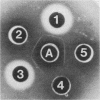Abstract
The infection of Streptococcus pyogenes T25(3) with the temperate bacteriophage T12 results in the conversion of the nontoxigenic strain to type A streptococcal exotoxin (erythrogenic toxin) production. Although previous research has established that integration of the bacteriophage genome into the host chromosome is not essential for exotoxin production, the location of the gene on the bacteriophage or bacterial chromosome had not been determined. In the present investigation, recombinant DNA techniques were used to determine whether the gene specifying type A streptococcal exotoxin (speA) production is located on the bacteriophage chromosome. Bacteriophage T12 was obtained from S. pyogenes T25(3)(T12) by induction with mitomycin C, and after isolation of bacteriophage DNA by phenol-chloroform extraction, the DNA was digested with restriction enzymes and ligated with Escherichia coli plasmid pHP34 or the Streptococcus-E. coli shuttle vector pSA3. Transformation of E. coli HB101 with the recombinant molecules allowed selection of E. coli clones containing bacteriophage T12 genes. Immunological assays with specific antibody revealed the presence of type A streptococcal exotoxin in sonicates of E. coli transformants. Subcloning experiments localized the speA gene to a 1.7-kilobase segment of the bacteriophage T12 genome flanked by SalI and HindIII sites. Introduction of the pSA3 vector containing the speA gene into Streptococcus sanguis (Challis) resulted in transformants that secreted the type A exotoxin. Immunological analysis showed that the type A streptococcal exotoxin produced by E. coli and S. sanguis transformants was identical to the type A exotoxin produced by S. pyogenes T25(3)(T12). Southern blot hybridizations with the cloned fragment confirmed its presence in the bacteriophage T12 genome and its absence in the T25(3) nonlysogen. Therefore, the gene for type A streptococcal exotoxin is located in the bacteriophage genome, and conversion of S. pyogenes T25(3) to toxigenicity occurs in a manner similar to the conversion of Corynebacterium diphtheriae to toxigenicity by bacteriophage beta.
Full text
PDF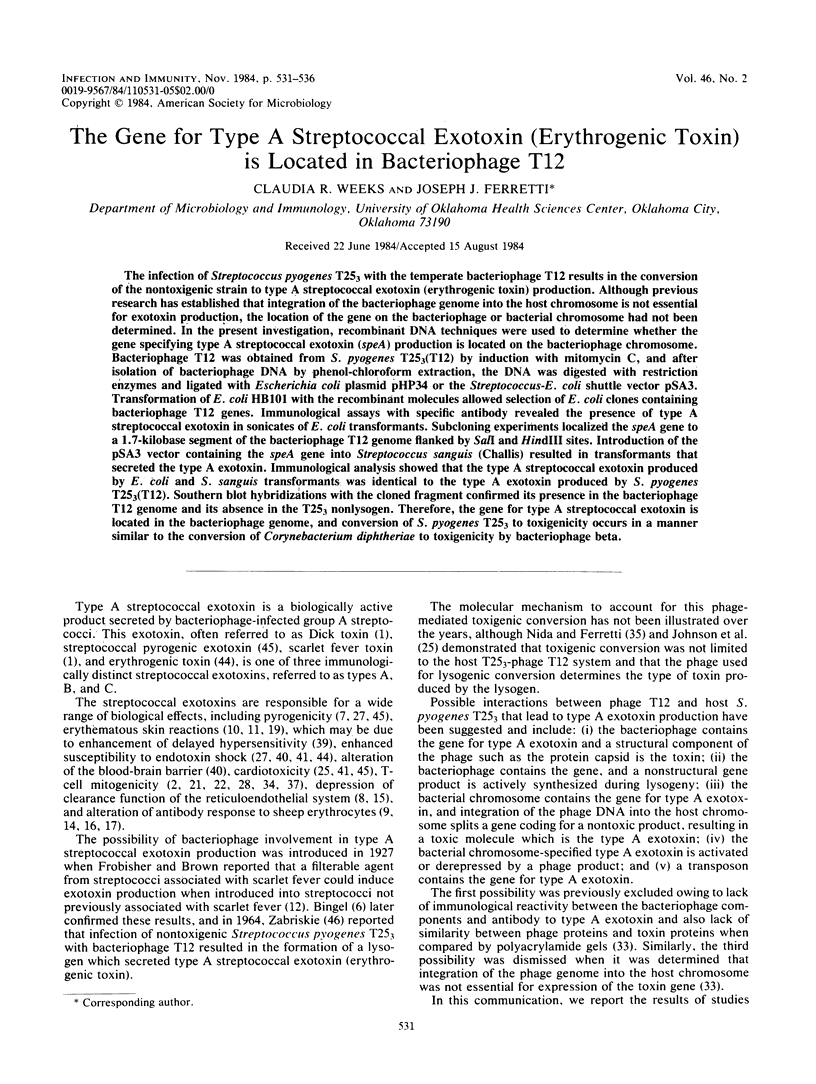
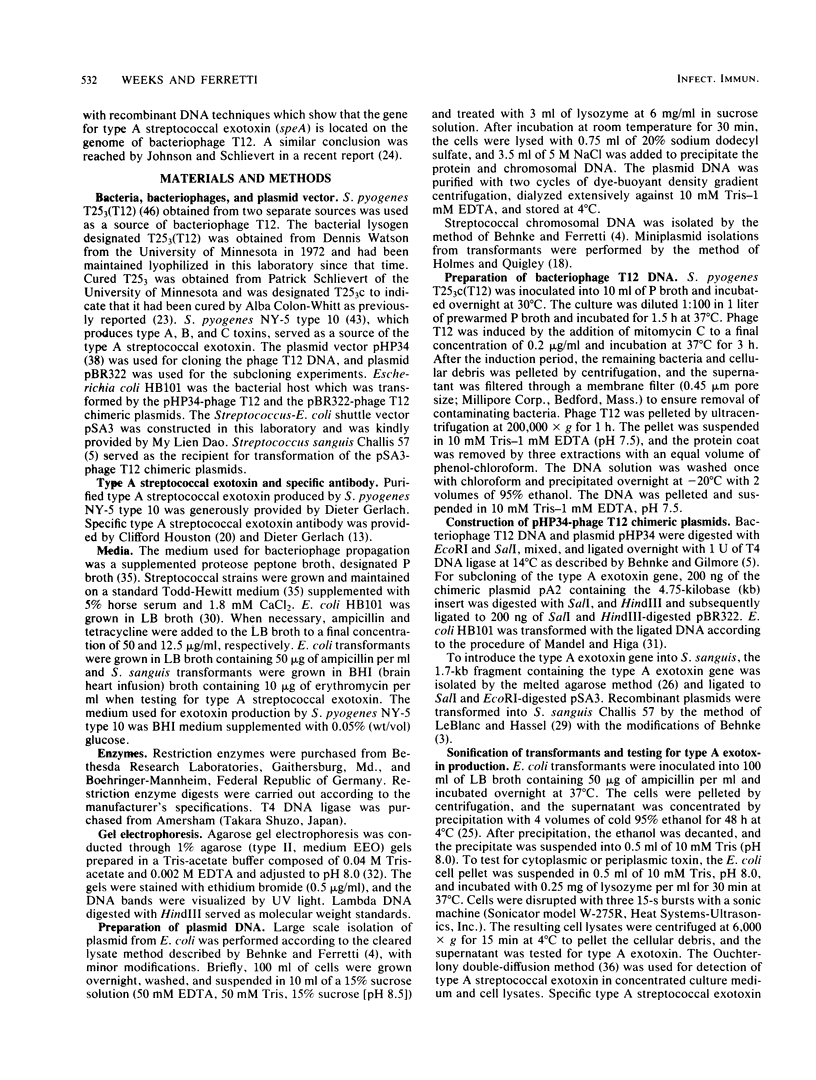
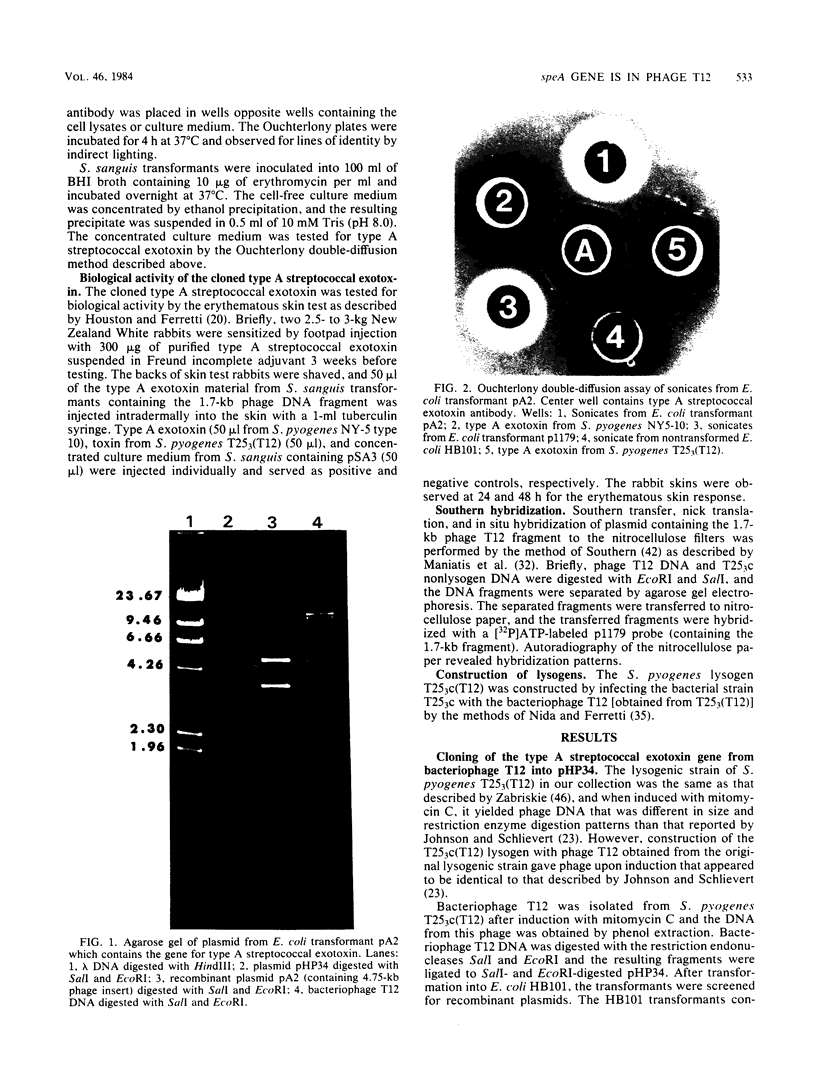
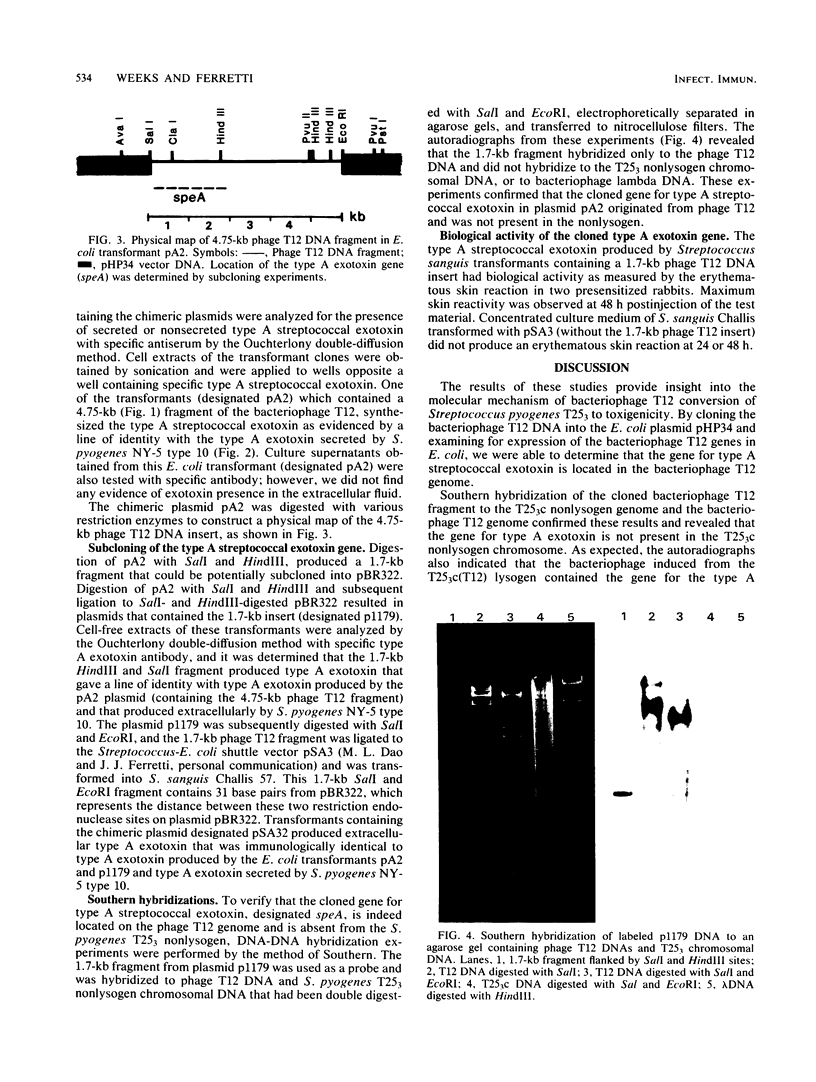
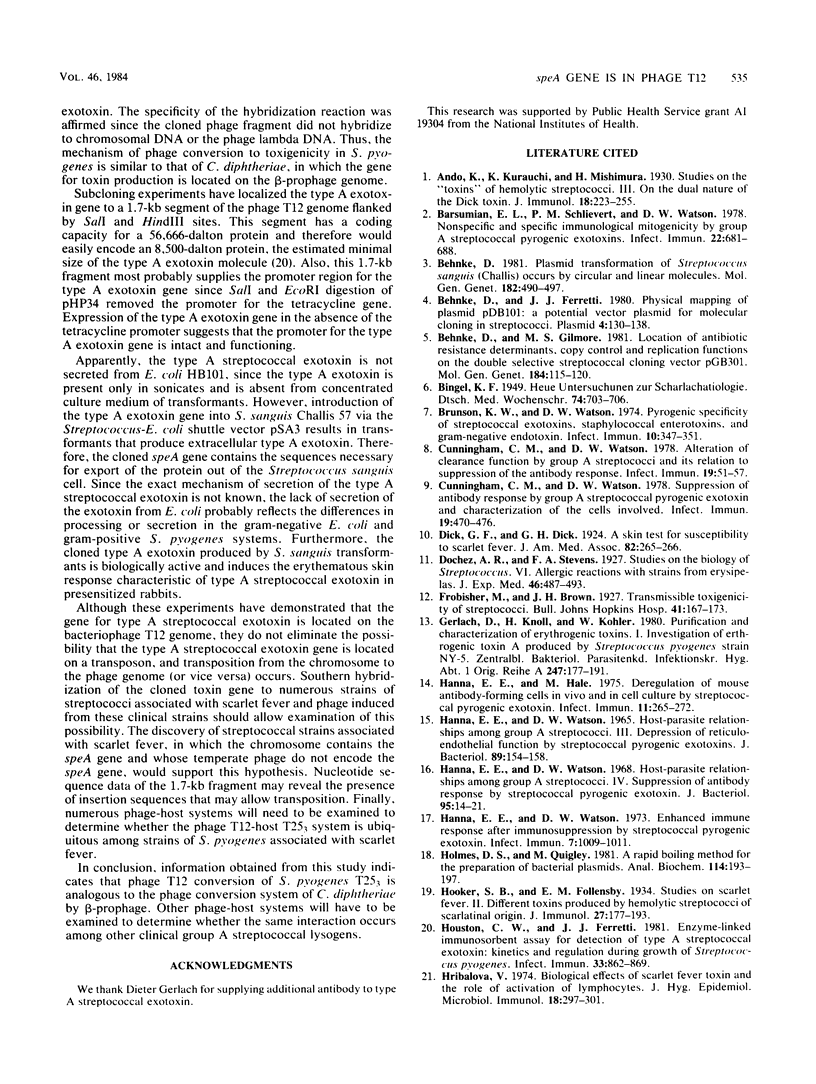

Images in this article
Selected References
These references are in PubMed. This may not be the complete list of references from this article.
- Barsumian E. L., Schlievert P. M., Watson D. W. Nonspecific and specific immunological mitogenicity by group A streptococcal pyrogenic exotoxins. Infect Immun. 1978 Dec;22(3):681–688. doi: 10.1128/iai.22.3.681-688.1978. [DOI] [PMC free article] [PubMed] [Google Scholar]
- Behnke D., Ferretti J. J. Physical mapping of plasmid pDB101: a potential vector plasmid for molecular cloning in streptococci. Plasmid. 1980 Sep;4(2):130–138. doi: 10.1016/0147-619x(80)90002-5. [DOI] [PubMed] [Google Scholar]
- Behnke D., Gilmore M. S. Location of antibiotic resistance determinants, copy control, and replication functions on the double-selective streptococcal cloning vector pGB301. Mol Gen Genet. 1981;184(1):115–120. doi: 10.1007/BF00271206. [DOI] [PubMed] [Google Scholar]
- Behnke D. Plasmid transformation of Streptococcus sanguis (Challis) occurs by circular and linear molecules. Mol Gen Genet. 1981;182(3):490–497. doi: 10.1007/BF00293940. [DOI] [PubMed] [Google Scholar]
- Brunson K. W., Watson D. W. Pyrogenic specificity of streptococcal exotoxins, staphylococcal enterotoxin, and gram-negative endotoxin. Infect Immun. 1974 Aug;10(2):347–351. doi: 10.1128/iai.10.2.347-351.1974. [DOI] [PMC free article] [PubMed] [Google Scholar]
- Cunningham C. M., Watson D. W. Alteration of clearance function by group A streptococcal pyrogenic exotoxin and its relation to suppression of the antibody response. Infect Immun. 1978 Jan;19(1):51–57. doi: 10.1128/iai.19.1.51-57.1978. [DOI] [PMC free article] [PubMed] [Google Scholar]
- Cunningham C. M., Watson D. W. Suppression of antibody response by group A streptococcal pyrogenic exotoxin and characterization of the cells involved. Infect Immun. 1978 Feb;19(2):470–476. doi: 10.1128/iai.19.2.470-476.1978. [DOI] [PMC free article] [PubMed] [Google Scholar]
- HANNA E. E., WATSON D. W. HOST-PARASITE RELATIONSHIPS AMONG GROUP A STREPTOCOCCI. 3. DEPRESSION OF RETICULOENDOTHELIAL FUNCTION BY STREPTOCOCCAL PYROGENIC EXOTOXINS. J Bacteriol. 1965 Jan;89:154–158. doi: 10.1128/jb.89.1.154-158.1965. [DOI] [PMC free article] [PubMed] [Google Scholar]
- Hanna E. E., Hale M. Deregulation of mouse antibody-forming cells in vivo in cell culture by streptococcal pyrogenic exotoxin. Infect Immun. 1975 Feb;11(2):265–272. doi: 10.1128/iai.11.2.265-272.1975. [DOI] [PMC free article] [PubMed] [Google Scholar]
- Hanna E. E., Watson D. W. Enhanced immune response after immunosuppression by Streptococcal pyrogenic exotoxin. Infect Immun. 1973 Jun;7(6):1009–1011. doi: 10.1128/iai.7.6.1009-1011.1973. [DOI] [PMC free article] [PubMed] [Google Scholar]
- Hanna E. E., Watson D. W. Host-parasite relationships among group A streptococci. IV. Suppression of antibody response by streptococcal pyrogenic exotoxin. J Bacteriol. 1968 Jan;95(1):14–21. doi: 10.1128/jb.95.1.14-21.1968. [DOI] [PMC free article] [PubMed] [Google Scholar]
- Holmes D. S., Quigley M. A rapid boiling method for the preparation of bacterial plasmids. Anal Biochem. 1981 Jun;114(1):193–197. doi: 10.1016/0003-2697(81)90473-5. [DOI] [PubMed] [Google Scholar]
- Houston C. W., Ferretti J. J. Enzyme-linked immunosorbent assay for detection of type A streptococcal exotoxin: kinetics and regulation during growth of Streptococcus pyogenes. Infect Immun. 1981 Sep;33(3):862–869. doi: 10.1128/iai.33.3.862-869.1981. [DOI] [PMC free article] [PubMed] [Google Scholar]
- Hríbalová V. Biological effects of scarlet fever toxin and the role of activation of lymphocytes. J Hyg Epidemiol Microbiol Immunol. 1974;18(3):297–301. [PubMed] [Google Scholar]
- Hríbalová V., Pospísil M. Lymphocyte-stimulating activity of scarlet fever toxin. Experientia. 1973 Jun 15;29(6):704–705. doi: 10.1007/BF01944787. [DOI] [PubMed] [Google Scholar]
- Johnson L. P., Schlievert P. M. A physical map of the group A streptococcal pyrogenic exotoxin bacteriophage T12 genome. Mol Gen Genet. 1983;189(2):251–255. doi: 10.1007/BF00337813. [DOI] [PubMed] [Google Scholar]
- Johnson L. P., Schlievert P. M. Group A streptococcal phage T12 carries the structural gene for pyrogenic exotoxin type A. Mol Gen Genet. 1984;194(1-2):52–56. doi: 10.1007/BF00383496. [DOI] [PubMed] [Google Scholar]
- Johnson L. P., Schlievert P. M., Watson D. W. Transfer of group A streptococcal pyrogenic exotoxin production to nontoxigenic strains of lysogenic conversion. Infect Immun. 1980 Apr;28(1):254–257. doi: 10.1128/iai.28.1.254-257.1980. [DOI] [PMC free article] [PubMed] [Google Scholar]
- Kim Y. B., Watson D. W. A purified group A streptococcal pyrogenic exotoxin. Physiochemical and biological properties including the enhancement of susceptibility to endotoxin lethal shock. J Exp Med. 1970 Mar 1;131(3):611–622. doi: 10.1084/jem.131.3.611. [DOI] [PMC free article] [PubMed] [Google Scholar]
- Knöll H., Petermann F., Köhler W. Untersuchungen zur Mitogenität erythrogener Toxine. II. Mitteilung: Nachweis erythrogener Toxine in Kulturfiltraten von Streptococcus pyogenes. Zentralbl Bakteriol Orig A. 1978 Jun;240(4):466–473. [PubMed] [Google Scholar]
- Kühn S., Fritz H. J., Starlinger P. Close vicinity of IS1 integration sites in the leader sequence of the gal operon of E. coli. Mol Gen Genet. 1979 Jan 2;167(3):235–241. doi: 10.1007/BF00267414. [DOI] [PubMed] [Google Scholar]
- LENNOX E. S. Transduction of linked genetic characters of the host by bacteriophage P1. Virology. 1955 Jul;1(2):190–206. doi: 10.1016/0042-6822(55)90016-7. [DOI] [PubMed] [Google Scholar]
- LeBlanc D. J., Hassell F. P. Transformation of Streptococcus sanguis Challis by plasmid deoxyribonucleic acid from Streptococcus faecalis. J Bacteriol. 1976 Oct;128(1):347–355. doi: 10.1128/jb.128.1.347-355.1976. [DOI] [PMC free article] [PubMed] [Google Scholar]
- McKane L., Ferretti J. J. Phage-host interactions and the production of type A streptococcal exotoxin in group A streptococci. Infect Immun. 1981 Dec;34(3):915–919. doi: 10.1128/iai.34.3.915-919.1981. [DOI] [PMC free article] [PubMed] [Google Scholar]
- Nauciel C. Mitogenic activity of purified streptococcal erythrogenic toxin on lymphocytes. Ann Immunol (Paris) 1973 Aug;124(3):383–390. [PubMed] [Google Scholar]
- Nida S. K., Ferretti J. J. Phage influence on the synthesis of extracellular toxins in group A streptococci. Infect Immun. 1982 May;36(2):745–750. doi: 10.1128/iai.36.2.745-750.1982. [DOI] [PMC free article] [PubMed] [Google Scholar]
- OUCHTERLONY O. Antigen-antibody reactions in gels. IV. Types of reactions in coordinated systems of diffusion. Acta Pathol Microbiol Scand. 1953;32(2):230–240. [PubMed] [Google Scholar]
- Petermann F., Knöll H., Köhler W. Untersuchungen zur Mitogenität erythrogener Toxine. I. Typenspezifische Hemmung der mitogenen Aktivität erythrogener Toxine durch antitoxische Seren von Kaninchen. Zentralbl Bakteriol Orig A. 1978 Apr;240(3):366–379. [PubMed] [Google Scholar]
- Prentki P., Krisch H. M. A modified pBR322 vector with improved properties for the cloning, recovery, and sequencing of blunt-ended DNA fragments. Gene. 1982 Feb;17(2):189–196. doi: 10.1016/0378-1119(82)90072-5. [DOI] [PubMed] [Google Scholar]
- SCHWAB J. H., WATSON D. W., CROMARTIE W. J. Further studies of group A streptococcal factors with lethal and cardiotoxic properties. J Infect Dis. 1955 Jan-Feb;96(1):14–18. doi: 10.1093/infdis/96.1.14. [DOI] [PubMed] [Google Scholar]
- Schlievert P. M., Bettin K. M., Watson D. W. Reinterpretation of the Dick test: role of group A streptococcal pyrogenic exotoxin. Infect Immun. 1979 Nov;26(2):467–472. doi: 10.1128/iai.26.2.467-472.1979. [DOI] [PMC free article] [PubMed] [Google Scholar]
- Schlievert P. M., Watson D. W. Group A streptococcal pyrogenic exotoxin: pyrogenicity, alteration of blood-brain barrier, and separation of sites for pyrogenicity and enhancement of lethal endotoxin shock. Infect Immun. 1978 Sep;21(3):753–763. doi: 10.1128/iai.21.3.753-763.1978. [DOI] [PMC free article] [PubMed] [Google Scholar]
- Southern E. M. Detection of specific sequences among DNA fragments separated by gel electrophoresis. J Mol Biol. 1975 Nov 5;98(3):503–517. doi: 10.1016/s0022-2836(75)80083-0. [DOI] [PubMed] [Google Scholar]
- WATSON D. W. Host-parasite factors in group A streptococcal infections. Pyrogenic and other effects of immunologic distinct exotoxins related to scarlet fever toxins. J Exp Med. 1960 Feb 1;111:255–284. doi: 10.1084/jem.111.2.255. [DOI] [PMC free article] [PubMed] [Google Scholar]
- ZABRISKIE J. B. THE ROLE OF TEMPERATE BACTERIOPHAGE IN THE PRODUCTION OF ERYTHROGENIC TOXIN BY GROUP A STREPTOCOCCI. J Exp Med. 1964 May 1;119:761–780. doi: 10.1084/jem.119.5.761. [DOI] [PMC free article] [PubMed] [Google Scholar]



